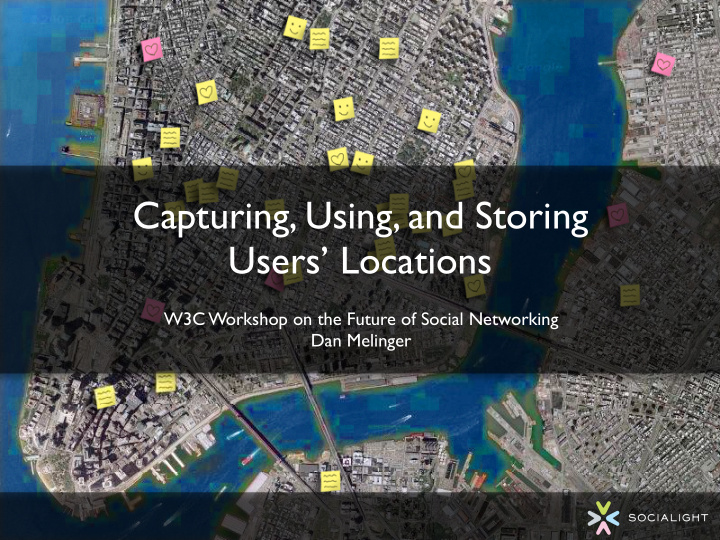



1 Capturing, Using, and Storing Users’ Locations W3C Workshop on the Future of Social Networking Dan Melinger
2 Outline 1. What’s special about location? 2. How’s location being used in web and mobile today? 3. Where are the intersections with social networks? 4. What are the inherent risks? 5. Shifting control, shifting risk. 6. Areas for discussion.
3 What’s special about location? • It relates back to the physical world. • It can be used (or misused) to tie a person to an activity. • It changes all the time. • Levels of granularity, levels of accuracy, levels of permission change for the same entities.
4 Location in Web and Mobile Today Class Examples retail prices, venue data, data WiFi access points, weather maps, point-to-point directions via driving, mapping and routing walking, or mass transit venue reviews, local blog posts, stories, content photos, videos, and sound communicate with people or businesses nearby communications friend or family, workforce tracking (All these classes are sometimes enabled by social networks.)
5 * Note I’m not speaking about how location is gathered nor how applications interact with application data. GPS, A-GPS, WPS, TDOA, U-TDOA, E-OTD, CellID W3C spec (draft) for geolocation APIs: http://www.w3.org/TR/geolocation-API/ (Still calls for privacy considerations for recipients of location information.)
6 Inherent Privacy Risks Two kinds: 1. Privacy implications around sharing sensitive data - Not just with one person or entity, - ...with a network of people. 2. Freedom from intrusion.
7 Shifting Control, Shifting Risk • Control shifting from mobile carriers to users. • (Increasingly...) location determination is becoming a function of the device rather than the network. - Good: the user is in control of their own data. - Bad: the user is in control of their own data. • One app. can leverage location provided by another: location sharing and location brokers.
8 Areas for Discussion Capture Usage Sharing Storage
9 Location Information Capture • Is it clear to the user when their location is collected (automatically or manually)? • Can the user turn location information collection off? If so, when? • Does the user have control over the specificity of their location that is being captured?
10 Location Information Usage • Is it clear to the user in what instances their location is being used? • Is the user’s location being transmitted across the network? Are transmissions secure? • Will the user’s location be correlated with personally identifiable information (in the social interface)?
11 Location Information Sharing • Will the user’s location be shared with other user’s of the application? If so, when and with what users? • Will the user’s location be shared with any third parties? If so, what third parties and with what specificity? What level of control does the user have over sharing? • Can stored information be retrieved by the user? • Can stored information be retrieved by another application? • In what formats can the information be retrieved?
12 Location Information Storage • Will a historical record of past locations be retained? • For how long and how many records? • Will this record be correlated with personally identifiable information? Will records be correlated with any additional information that is not directly personally identifiable? • How secure are storage facilities? • What format? See Online Presence Ontology (OPO) paper. • Can stored information be deleted by the user?
13 Thank you. Contact: Visit: Dan Melinger mobile: m.socialight.com web: dan@socialight.com socialight.com video: blip.tv/file/218742/ mobile: +1 917 494 5856 skype: melinger socialight: dan 36 East 12th Street New York, NY 10003
Recommend
More recommend